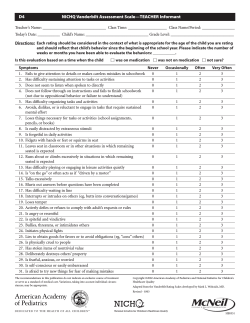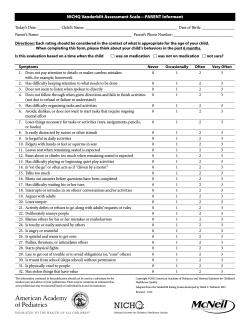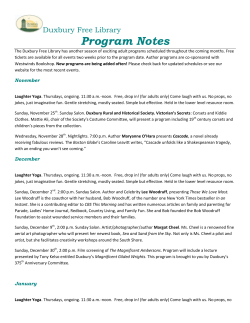
Module 2 DEVELOPMENTAL OBSERVATION TOPIC: ENVIRONMENT FOR PARENT-CHILD OBSERVATION:
Module 2 Handout 2.6: PIWI/Developmental Observation Topic (DOT) Plan Age Range: Birth – 36 months DEVELOPMENTAL OBSERVATION TOPIC: What makes me laugh? ENVIRONMENT FOR PARENT-CHILD OBSERVATION: For today, prepare an interesting environment using objects and activities that the parents and children have enjoyed together during past sessions. Some suggestions are: toys that have an element of surprise such as a jack-in-the-box; mirrors to make funny faces; “What Makes Me Laugh?” activity sheet taped to a mirror (included in this handout); fun dress up materials like hats, scarves, boas, feathers; puppet box with puppets; music area with audio tapes of a variety of songs where parents and children can do silly dances; sheet hanging on a door or streamers on a box to play peek-a-boo; books. What makes me laugh? OPENING DISCUSSION: Hello Song: Hello (child’s name), Hello (parent’s name), How are you?, How are you? We’re so glad to see you! We’re so glad to see you! Come and play! Come and play! Introducing the Developmental Observation Topic: We have been talking about emotions and trying to figure out our children’s signals and cues—what they are trying to tell us! Today we are going to have fun laughing together! We are going to talk about the different kinds of things that make our children laugh, and how these change as children get older. Think back over the past week or so—what can you think of that made your child laugh? (Facilitator: record the “laughing” situations on a big piece of paper that you can refer back to during the closing discussion). Often with very young children, laughter occurs mostly when you are doing something physical to them, like moving their legs up and down or playing tickling games. They also like auditory stimulation, like when you make popping noises or growling sounds. Pretty soon they also begin to laugh at games like “I’m gonna get you” because they begin to anticipate that tickle at the end! They also think it’s funny when you do something silly, like put on a funny hat or walk in a funny way. When they get a little older, they laugh at things they see. And pretty soon they laugh at what they think is going to happen next! Often, these situations involve an adult or older child who is intent on making them laugh. Eventually, as they begin to develop language, they will become very interested in hearing and telling simple jokes. As children get older, they also begin to initiate their own funnies; for example, they will make up words for things, and then go into gales of laughter. They begin to notice things going on around them, and to laugh at these as well. As they get even older, they are thinking about what they see, and begin to see humor in ideas, just as we do as adults. 7/08 The Center on the Social and Emotional Foundations for Early Learning Vanderbilt University vanderbilt.edu/csefel H 2.6 Module 2 Handout 2.6: PIWI/Developmental Observation Topic (DOT) Plan Today, we are going to see what kinds of objects/actions make your children laugh. We are going to have several “laugh stations” scattered around the room. As you are moving around the room following your child’s lead, try some of the activities that we have listed, and see what happens. Suggestions for Things to Try: 1. Use funny voices with you child (high and low sounds; unusual sounds 2. Hide a puppet and then have it jump out, talk in funny voices using the puppets 3. Hide your face behind a box or chair, then pop out on different sides 4. Put something unexpected like a shirt or a toy on top of your head & act silly 5. Play an “I’m gonna get you” game 6. Play “peek-a-boo” 7. Put mask over your face and take it off 8. Put a cloth in your mouth and shake your head like a puppy 9. Make up nonsense names for familiar objects – for example, call a block a “gobble” or a slide a “slippery” 10. Do silly dances/movements to music Be sure to smile and laugh as you engage in these games with your child! Have fun together! Predictions: What do you think will make your child laugh? Which materials/objects will they find funny? What do you think you will have to do to make things funny for your child… to make your child laugh? How will your child let you know that something is funny to them? “Let’s go play and see what makes your children laugh!” PARENT-CHILD OBSERVATION ACTIVITIES (notes for facilitators): As you interact with each dyad, briefly comment to parents about situations in which you have seen their child laughing. Share with parents what it was about these situations that the child seemed to enjoy. As the parent tries the “things to try”, talk to them about their observations and explain how what they are doing supports their child’s social and emotional development. Which things works best? Why? Talk about how the child is letting them know that it is funny – that they like it. If the parent wants to learn more strategies for supporting their child’s development, point out how laughter is related to other aspects of development. For example, as the parent and child play together, the child is learning to express positive emotions. When they are dancing and being silly together, the child is using all kinds of developmental skills (motor, language/communication, social/emotional & cognitive). The “things to try” are also a good way to help the child practice and become more skillful at using their thinking skills, including predicting what will happen next. Humor can be a great motivator for learning! 7/08 The Center on the Social and Emotional Foundations for Early Learning Vanderbilt University vanderbilt.edu/csefel H 2.6 Module 2 Handout 2.6: PIWI/Developmental Observation Topic (DOT) Plan TRANSITION (from observation/play activity time to snack) Everyone could so a silly dance to transition from play to snack. Parents with infants can hold their infants and talk/sing to the infant as they “dance” to the snack area. SNACK AND INFORMAL CONVERSATION: Could use crackers or fruit with peanut butter and raisins to have parents and children make funny faces, etc… TRANSITION (from snack to parent-child songs and games): Use bubbles to entice children back to the central rug area. PARENT-CHILD SONGS AND GAMES: Some of the anticipation aspects of the “thing to try” are already part of many parent-child songs and games. Try the following rhyme, even the youngest children will laugh as they are tickled and the older children will begin to laugh even before the tickle. The bumble bee went around the tree (moving fingers slowly in a circle just above the child’s tummy), buzz-zoom, buzz-zoom, buzz zoom (with lots of intonation, still moving the hand in circles, but closer in to the belly), Until it found me! (swooping down for the tickle). Any song or game that contains elements of surprise can be used in the same way. Have parents share their favorite songs and games. CLOSING DISCUSSION: Reviewing Predictions: Ask parents what their children laughed at? What did they observe? Was it what they predicted? What were some of the things that they tried (strategies) that caused their children to laugh? Did their children do anything that surprised them? What did they learn about their children? Main Points: When children are very young, they don’t yet have enough images in their heads that something can be unexpected or surprising. Instead, they laugh at physical stimulation (like tickling) and auditory stimulation (like making popping noises or growling). Pretty soon they begin to laugh at games like “I’m gonna get you” because they begin to expect that tickle at the end. They also think it’s funny when you do something silly. Eventually, as they begin to develop language, they will become very interested in hearing and telling simple jokes. As children get older, they initiate their own funnies and make up words for things. For us as adults, what children laugh at provides a window into their brains, into how they are beginning to understand their world, into how they are communicating their wants, needs and feelings. Humor is very much related to children’s current ways of thinking. But laughter is also good for development! It feels good to laugh. Laughter connects us to other people, and makes us 7/08 The Center on the Social and Emotional Foundations for Early Learning Vanderbilt University vanderbilt.edu/csefel H 2.6 Module 2 Handout 2.6: PIWI/Developmental Observation Topic (DOT) Plan feel good about ourselves. It also is very motivating. For example, humor keeps us interested. And things like jokes can help to develop thinking skills. Laughing also relieves tension. So one of the things we can do to support children’s development is to help then develop a sense of humor! But most of all, laughing together and just enjoying your child will make your child feel loved and special! Helping Your Child Grow: How can we help children develop a sense of humor? Are there situations you can think of at home where you already do things that make your child laugh? Are there new things that you thought of as we were going through today’s activities and discussion that you might try at home? One of the most important things we can do is to enjoy funny situations ourselves. And give children plenty of opportunities to experience the kinds of things we have tried today. And, as they get older, join in their laughter when they do something they think is funny. Then learn some simple children’s jokes and begin to share and enjoy them! (Note to Facilitators: Parents might enjoy a handout of today’s “things to try” to take home. You might also want to find one or two “beginner jokes” to write out for them to take home—these should be very much at the beginning stage for children in this age range.) Good-bye Song: Good-bye (child’s name), good-bye (parent’s name), good-bye (child’s name), we’re glad you came to play! 7/08 The Center on the Social and Emotional Foundations for Early Learning Vanderbilt University vanderbilt.edu/csefel H 2.6 Module 2 Handout 2.6: PIWI/Developmental Observation Topic (DOT) Plan What Makes Me Laugh? Place your child in your lap, hold the mirror so both of you can see, and then try some of the fun ideas below to see what makes your child laugh! Try to touch your nose with your tongue Puff out your cheeks Pucker your lips Make “kissy” sounds while kissing your child Say, “I see you!” and point to your child in the mirror Lick your lips Make funny faces Play “peek-a-boo” Try to whistle 7/08 The Center on the Social and Emotional Foundations for Early Learning Vanderbilt University vanderbilt.edu/csefel H 2.6
© Copyright 2025





















